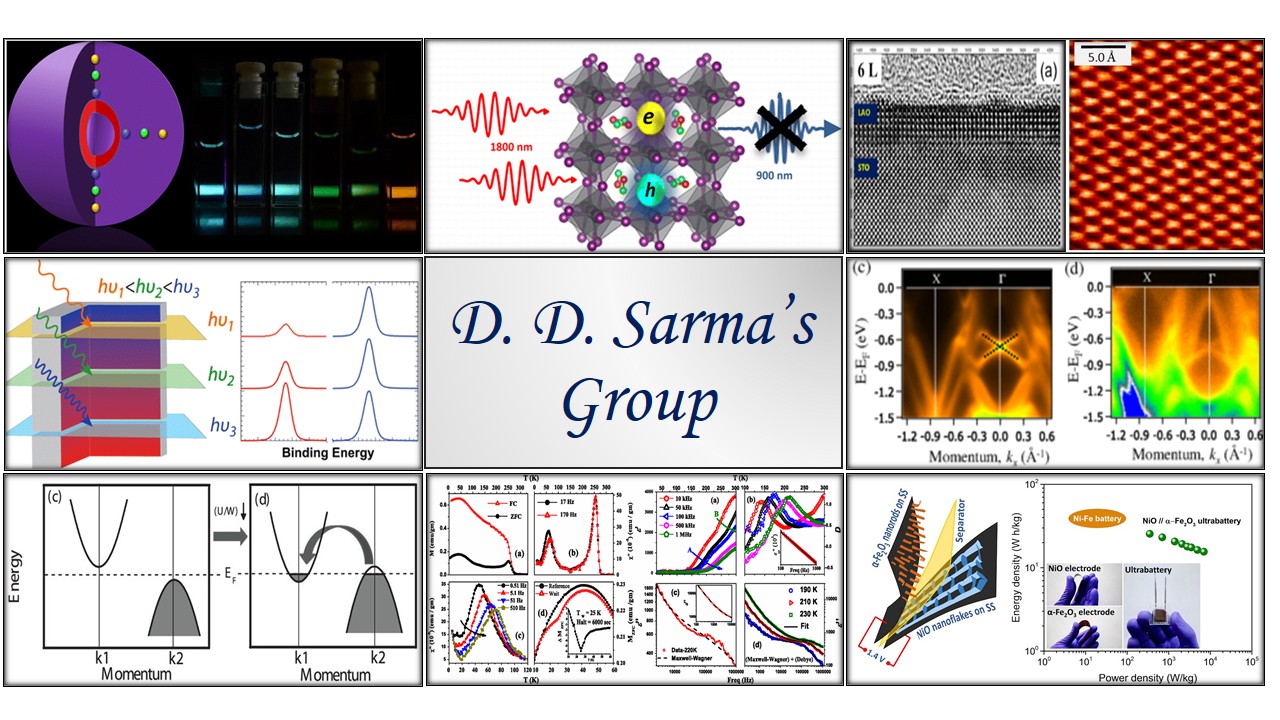|

Click on the individual image for more details
Research areas:
Strongly Correlated Electron Systems
The main research interest of our group is related to the electronic structure of strongly interacting electronic systems, primarily based on transition metal oxides, sulfides and selenides. Investigation of the effect of disorder on the electronic structure in simultaneous presence of strong interaction effects constitutes another major effort. Changes in the electronic structure, with a particular emphasis on metal-insulator transition, driven by changing correlation effect or bandwidth, doping level, dimensionality, extent of disorder and physical parameters such as temperature and pressure are probed employing various experimental and theoretical approaches. Also, there is a significant effort in our group to understand magnetic structures of different systems that have fascinating magnetic properties, especially colossal magnetoresistance property. Experimental probes consist of a wide range of energy spectroscopies, such as photoemission, inverse photoemission, X-ray absorption, Auger electron spectroscopies, scanning tunneling spectroscopies and many other using synchrotron and laboratory based facilities, supplimented by transport and magnetic measurements.
Theories of strongly correlated systems are pursued along two major routes. One involves theoretical analysis of non-magnetic (XPS, Auger, XAS, etc) and magnetic (XMCD) high energy electron spectroscopies through exact and iterative diagonalizations of many-body Hamiltonians for finite sized clusters. The other part of the effort is devoted to the restricted and unrestricted Hartree-Fock studies of electronic and magnetic phase transitions in complex inorganic materials. These calculations are often assisted and augmented by ab-initio band structure (LMTO and LAPW) calculations.
Nanoparticles
One of the major areas of research in the group is based on the chemistry and physics of semiconducting nanoparticles in the quantum size regime. Controlling the size of various semiconducting particles, such as CdS, CdSe, CdSeS, ZnS, ZnSe, ZnO etc., typically in the range of a few tens of Angstroms allows one to tune the band gap and thereby obtain tailor-made electronic and optical properties. Doping magnetic impurities like Mn into these nanocrystals allows one to modify the luminescence as well as the magnetic properties, generating a tremendous potential for new electro-opto-magnetic devices with specific desired properties. Synthesis of these undoped and doped nanocrystals by various chemical routes, characterizing the electronic, optical and magnetic properties and experimentally investigating the microscopic electronic structure, stability and growth constitute a part of the research activity. Further more, the group is also actively involved in developing highly accurate theories to understand the band-gap tuning with size in various semiconducting nanocrystals quantitatively.
Energy Science
Our group has been involved in designing and understanding properties of diverse materials that
have relevance to the field of photovoltaics. Within one class of such materials, we have been investigating
intrinsic material properties of organic-inorganic hybrid perovskites, such as MAPbX3, in comparison to
their all inorganic counterparts, such as CsPbX3, in an attempt to understand the origin of remarkable
photovoltaic efficiencies of cells based on this class of materials. In another approach, we have designed a few
ferroelectric inorganic oxide perovskites which can absorb over a wider range of the solar spectrum compared to
standard ferroelectrics, such as BaTiO3, in an attempt to find more suitable ferroelectric PV materials.
We employ investigations of dielectric and optical properties, coupled with ultrafast charge carrier dynamics studies
and first principle electronic structure calculations to understand properties of such materials at a microscopic level.
Another direction of our research is in developing efficient ways to store electrical energy. Unlike in bulk materilas, electrochemical reactions
in nanostructured systems are governed by diffusion independent chnrge-transfer processes. Such types of
nanostructured surface phenomena are important to design miniaturized energy storage devices with enhanced energy
and power densities required for powering next-generation portable electronic devices. Keeping this in mind, our
group is involved in designing high-performance energy storage systems like batteries and supercapacitors, exploiting electrochemical
reactions at 1D/2D nanostructured electrodes of different transition metal oxides.
Electronic Structure calculations
The experimental results are interpreted with the help of various electronic structure calculations within the group. For strongly correlated systems, the calcultations performed are based on ab initio band structure, multiband Hubbard and Anderson impurity model calculations. Various high-energy spectroscopic results from strongly correlated systems are simulated within a many-body effects etc. studied extensively using different levels of approximate electronic structure calculations.
To gain insight into the underlying electronic structure of the semiconducting nanoparticles, we are pursuing various theoretical approaches leading to precise predictions of the properties like band gap tailoring. These calculations are used to understand the electronic structure and properties of nanoparticles of the II-VI and the III-V series of the periodic table along with studies of doped nanoparticles.
Conjugated Polymers
One of our past interest had been in the area of conjugated polymers. Apart from understanding the diverse properties of these systems through detailed investigation of electronic structure, our interest also lies in developing novel systems with improved properties. Thus, we synthesized a new class of conducting polyaniline (PANI), doped with Lewis acids that exhibit unusually high conductivity and remarkable thermal stability. Detailed study of transport and magnetic properties has revealed a unique "amorphous and yet metallic" state in these systems, in distinct contrast to the more conventional proton-doped PANI. Using various electron microscopy and spectroscopic techniques (XPS, UPS, XAS, STM and STS), we have studied the effect of dopant and the morphology on the electronic structure of these systems.
We have prepared a new class of functionalized PANI that exhibits a bright, deep blue photoluminescence.
|

